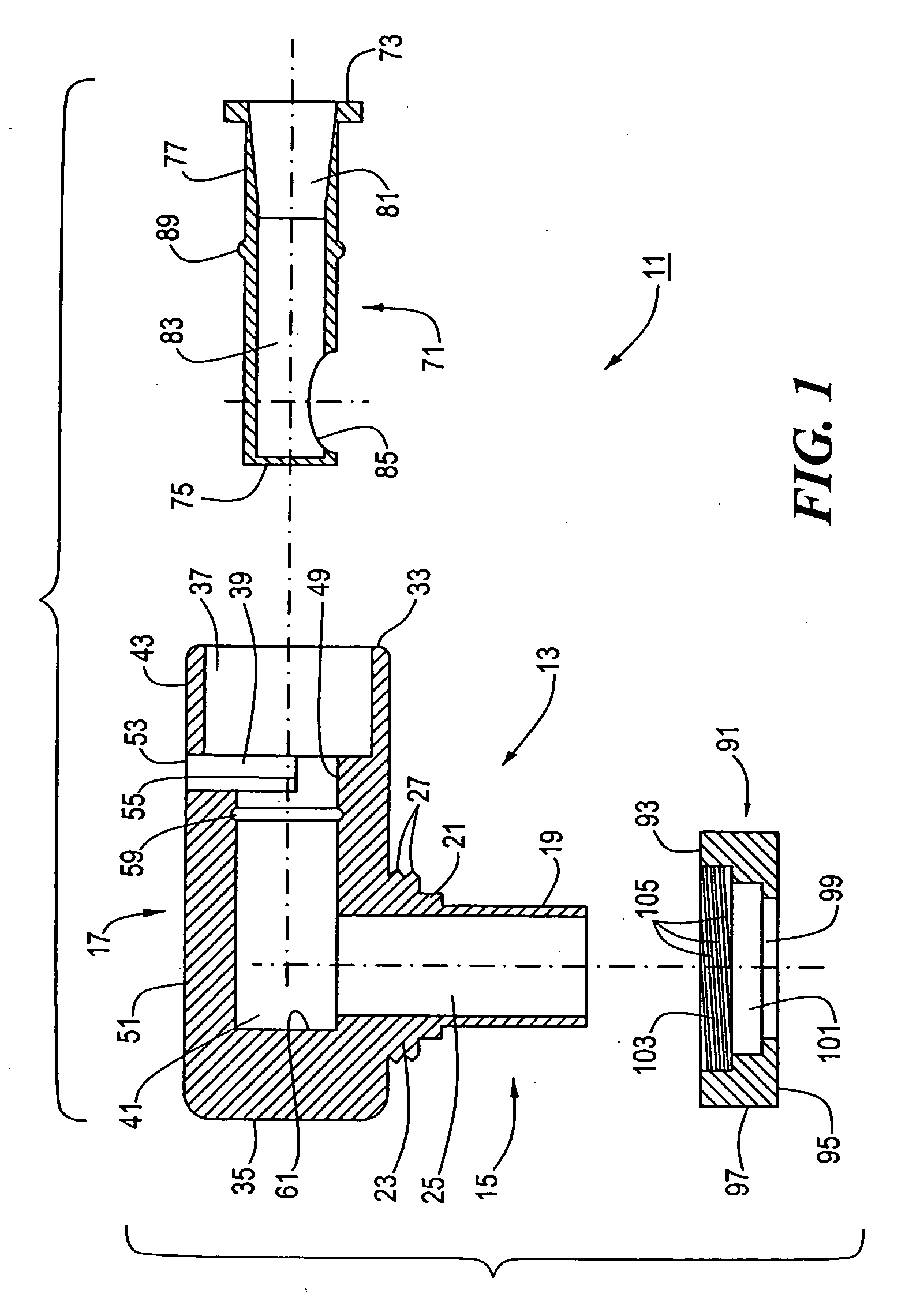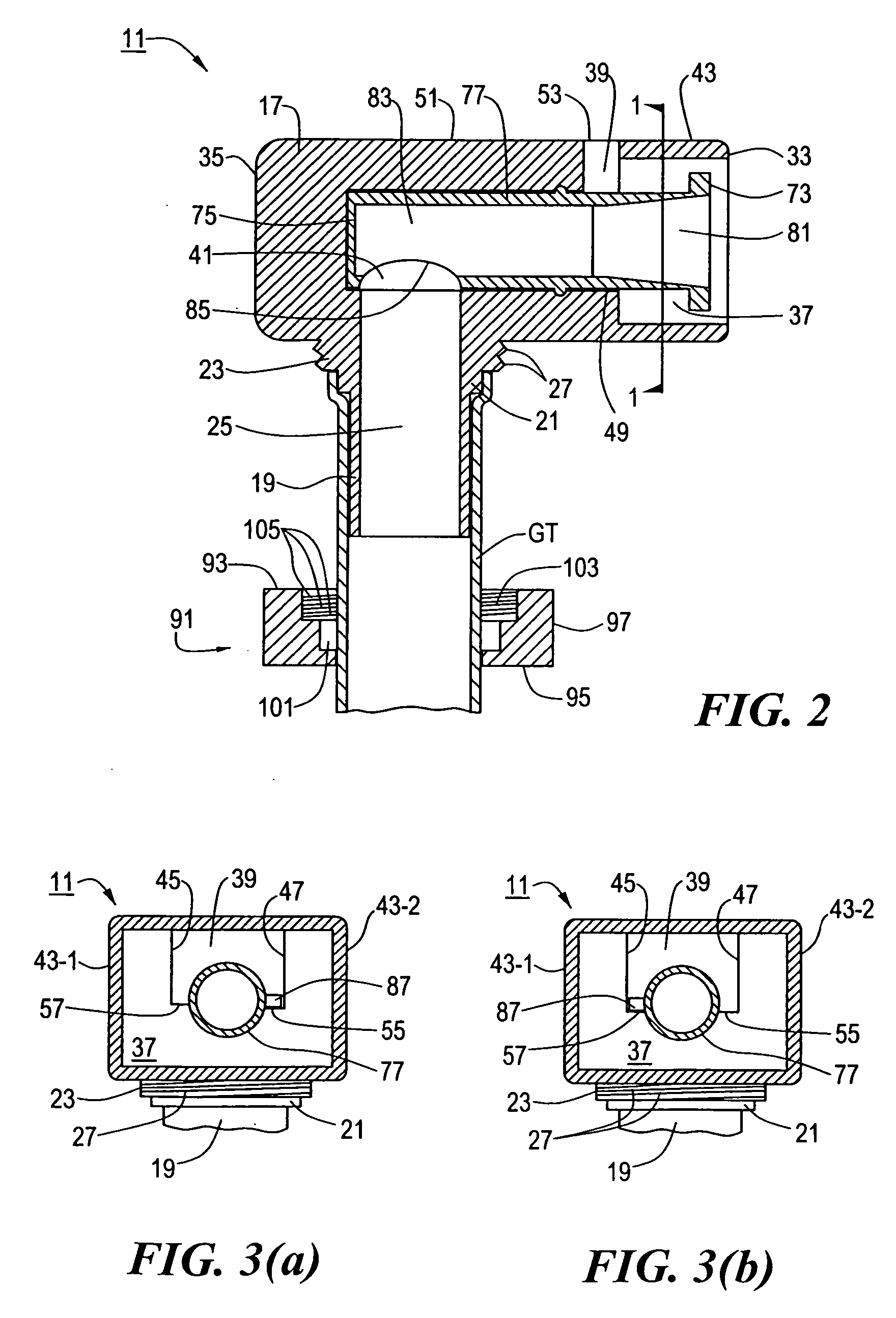Low profile adaptor for use with a medical catheter
a technology for adaptors and medical catheters, applied in the field of low-profile adaptors for use with medical catheters, can solve the problems of unsuitable long-term, nearly one foot length of tubing that extends externally, unwieldy, etc., and achieve the effect of low profil
- Summary
- Abstract
- Description
- Claims
- Application Information
AI Technical Summary
Benefits of technology
Problems solved by technology
Method used
Image
Examples
first embodiment
[0045] Referring now to FIGS. 1 through 5, there are shown various views of a low profile adaptor constructed according to the teachings of the present invention for use with a medical catheter, such as a gastrostomy feeding tube, said low profile adaptor being represented generally by reference numeral 11.
[0046] Adaptor 11 comprises a body 13. Body 13, which is preferably made of molded medical grade plastic, is a unitary member shaped to include a lower portion 15 and an upper portion 17, lower portion 15 extending generally vertically and upper portion 17 extending generally horizontally and being positioned over lower portion 15.
[0047] Lower portion 15, which is generally cylindrical, is shaped to define a tube support 19 and a pair of steps 21 and 23 of increasing outer diameter at the top end of support 19. (Although two steps 21 and 23 are shown in the present embodiment, it can readily be appreciated that greater than or less than two steps could be formed at the top end of...
second embodiment
[0056] Referring now to FIGS. 8 and 9, there are shown top and section views of a low profile adaptor constructed according to the teachings of the present invention for use with a medical catheter, such as a gastrostomy feeding tube, said low profile adaptor being represented generally by reference numeral 151.
[0057] Adaptor 151 is similar in most respects to adaptor 11, one difference between the two adaptors being that adaptor 151 comprises an upper portion 153 that, when viewed from above, is oval-shaped, as opposed to being hourglass-shaped. Another difference is that the front end 155 of upper portion 153 is shaped to shield stem 71 from the top and bottom, but not from the sides. Still another difference is that adaptor 151 comprises a nut 157 whose outer surface 159 includes a beveled region 161.
third embodiment
[0058] Referring now to FIGS. 10 and 11, there are shown top and section views of a low profile adaptor constructed according to the teachings of the present invention for use with a medical catheter, such as a gastrostomy feeding tube, said low profile adaptor being represented generally by reference numeral 201.
[0059] Adaptor 201 is similar in most respects to adaptor 11, one difference between the two adaptors being that adaptor 201 comprises an upper portion 203 that, when viewed from above, is generally rectangular with rounded ends, as opposed to being hourglass-shaped. Another difference is that adaptor 201 comprises a nut 205 having an outwardly extending flange 207. Still another difference is that adaptor 201 comprises a stem 209 having an open rear end 211.
PUM
 Login to View More
Login to View More Abstract
Description
Claims
Application Information
 Login to View More
Login to View More - R&D
- Intellectual Property
- Life Sciences
- Materials
- Tech Scout
- Unparalleled Data Quality
- Higher Quality Content
- 60% Fewer Hallucinations
Browse by: Latest US Patents, China's latest patents, Technical Efficacy Thesaurus, Application Domain, Technology Topic, Popular Technical Reports.
© 2025 PatSnap. All rights reserved.Legal|Privacy policy|Modern Slavery Act Transparency Statement|Sitemap|About US| Contact US: help@patsnap.com



